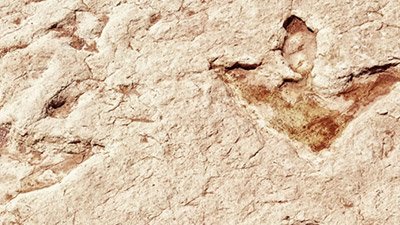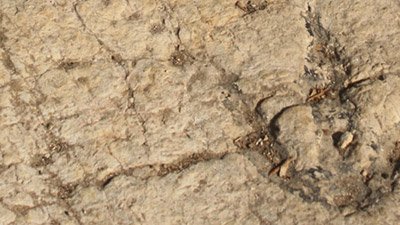
Discovering the Cause of Giant Dinosaur Stampede
The great dinosaur stampede mystery solved (again).
News Source
- Smithsonian blog: “What Caused the Dinosaur Stampede?”
Lark Quarry in Queensland is home to the only known fossil record of a dinosaur stampede. There, preserved in mid-Cretaceous rock, are about 3,300 individual tracks representing about 150 dinosaurs of varying sizes and kinds. They seem to be fleeing in the same direction. It’s not hard to imagine some great dinosaur tales to match the tracks. By reassessing these tracks using modern technology and trying to identify their owners, an international team of scientists whose efforts are chronicled in a TV-whodunit1 has tried to shed light on the real story.
As the scientists discuss the group dynamics of the one large and many small dinosaurs running across a mudflat, many make the usual assumptions—namely, that dinosaurs with claws and bones that look like they could run fast were obviously predatory carnivores “built to kill.” Some, however, think the large dinosaur was an herbivore that still probably managed to scare off the smaller dinos. The mystery becomes one of discovering the identity of the dinosaur that frightened all those little dinosaurs away from their watering hole 100 million years ago.
The film takes us to other trackways in Spain and North America. A common thread runs through the story of the tracks on three continents. That thread is water. Tracks can only be fossilized if they are pressed into a mineral-rich mud and then either dried quickly in air or buried quickly so that the overlying sediment preserves the muddy prints while the water is squeezed from them. The idea that tracks could have fossilized over millions of years begs credulity, for such tracks would be eroded and quickly lost. (In fact, to protect the Lark Quarry tracks from perishing even though they are fossilized, they are sheltered in a large protective facility.)
But the common thread goes beyond the mineral-laden water needed to form fossilized tracks and includes some additional features of trackways elsewhere. The film takes us to Red Gulch, Wyoming, to see a collection of Middle Jurassic dinosaur tracks 167 million years old by evolutionary reckoning. Dr. Michael Brett-Surman shows us ripple marks on the surface as well as fossilized shrimp burrows and fossilized clamshells embedded in the tracks. These findings, he explains, indicate a receding tide at the time these prints were made. The “obvious” conclusion, of course, is that the dinosaurs of Red Gulch frolicked in the intertidal region munching on seafood.
More ripple marks in northern Spain’s Lower Cretaceous Cameros Basin deepen the watery story. These ripple marks were formed by water at least three meters deep. Dr. Loic Costeur explains that the form of the scratch marks and tracks suggest their large theropod owner was trying to keep itself oriented directly upstream. Of course, the embedded video includes a computer-generated sequence showingthe hungry creature seeking its dinner in the river. Perhaps the creature was pursuing something to eat or drink. But perhaps something else was going on.
The surging waters rising during the first five months of the Flood would have brought mineral-rich ocean water and sediment inland, making a muddy place for creatures to press their prints as they fled the waters. Subsequent surges would have hauled in sediment to rapidly bury the prints and press the water from the cement-like mud.
That something else may well have been the onset of the global Flood. Footprints in rivers and on beaches would ordinarily wash away quickly. Preservation of tracks as fossils would have required mineral-laden mud and sudden burial of the pressed imprints. The surging waters rising during the first five months of the Flood would have brought mineral-rich ocean water and sediment inland, making a muddy place for creatures to press their prints as they fled the waters. Subsequent surges would have hauled in sediment to rapidly bury the prints and press the water from the cement-like mud.
The layers in the geologic column, several of which are represented in the film, tell the story of the order of burial as creatures were overcome by rising Floodwaters about 4,300 years ago. The geologic column is a timeline, but one representing months, not millions of years. And the tracks we see preserved in its layers are largely the result of animals fleeing rising water. So, while the stampede recorded at Lark Quarry may have been produced by skittish dinosaurs fleeing a “big, scary” dinosaur during the time Noahic floodwaters were rising, it may as likely represent a panic-stricken group of dinosaurs fleeing those very waters.
Those dinosaurs could not escape from the judgment that fell on the earth as a result of mankind’s rebellion against God. But man has a way to escape the judgment we all deserve for our rebellion. In the days of Noah, only eight people (1 Peter 3:20) availed themselves of God’s mercy. Today, the grace of God still beckons us to flee the judgment to come. The dinosaur stampede at Lark Quarry and the ripples and tracks at Red Gulch and Cameros Basin do have a story to tell. They should remind us of the stark reality of judgment and the importance of receiving God’s grace while we can.
Read more about that grace through Christ.
Further Reading
- Fossilized Footprints—A Dinosaur Dilemma
- Matching Footprint Found Under Protoceratops
- Tracks of Co-Existing Humans and Dinosaurs Found In China
- New Model of Meteorite Strike Reveals Extinction Theory
For More Information: Get Answers
Remember, if you see a news story that might merit some attention, let us know about it! (Note: if the story originates from the Associated Press, FOX News, MSNBC, the New York Times, or another major national media outlet, we will most likely have already heard about it.) And thanks to all of our readers who have submitted great news tips to us. If you didn’t catch all the latest News to Know, why not take a look to see what you’ve missed?
(Please note that links will take you directly to the source. Answers in Genesis is not responsible for content on the websites to which we refer. For more information, please see our Privacy Policy.)
Recommended Resources

Answers in Genesis is an apologetics ministry, dedicated to helping Christians defend their faith and proclaim the good news of Jesus Christ.
- Customer Service 800.778.3390
- © 2024 Answers in Genesis






